MXA RACE TEST: THE REAL TEST OF THE 2023 HONDA CRF250
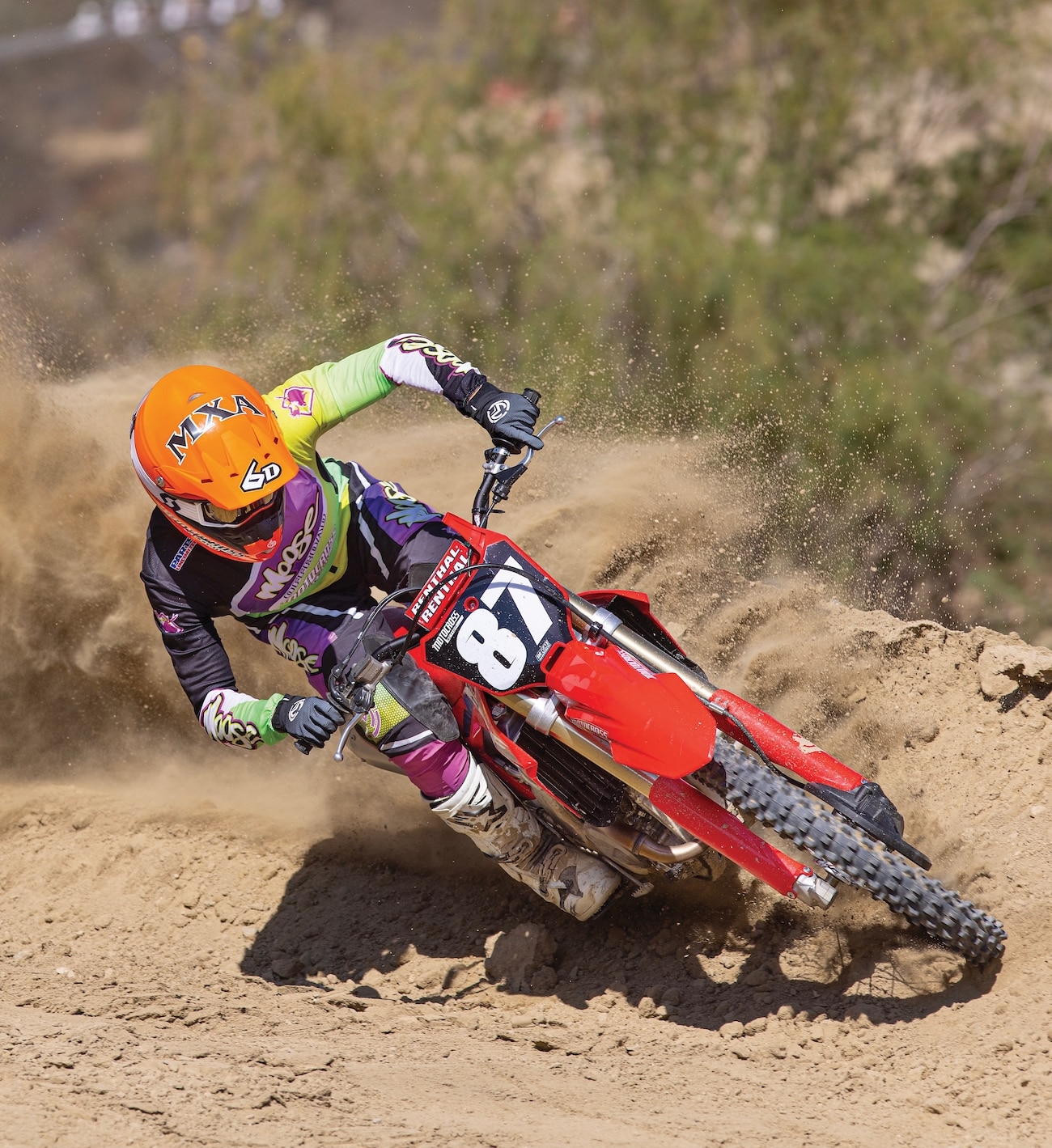 THE GEAR: Jersey: Moose Racing Sahara, Pants: Moose Racing Sahara, Helmet: 6D ATR-2, Goggles: Scott Prospect, Boots: Alpinestars Tech 10.
THE GEAR: Jersey: Moose Racing Sahara, Pants: Moose Racing Sahara, Helmet: 6D ATR-2, Goggles: Scott Prospect, Boots: Alpinestars Tech 10.
Q: FIRST AND FOREMOST, IS THE 2023 HONDA CRF250 BETTER THAN THE 2022 MODEL?
A: Want the short answer? No, it’s not. The 2018–2021 Honda CRF250 models were known for their comfortable chassis; plush, albeit soft, suspension; and turtle-like engines. In 2022, Honda introduced a new CRF250 and literally flipped the script. The 2022 CRF250 came with an exciting get-up-and-go powerband but with Showa forks that were too stiff for most 250 four-stroke riders. We wrote up a sizable list of complaints for the 2022 CRF250 and, unfortunately, Honda didn’t address any of them. The 2023 graphics have been changed, but even they are almost identical. The 2023 model isn’t any better than the 2022 bike. It’s the same model, only with a $100 upcharge, bringing the MSRP to $8199.
Q: WHAT HAS HONDA’S TRAJECTORY FOR THE CRF250 BEEN LIKE?
A: The CRF250 was all new last year, which explains why Honda felt they could cash in on the improvements they made 12 months ago without spending any R&D money this season. It is true that Honda made giant leaps forward in 2022 in the engine department, but they stepped backwards in the chassis department.
Honda’s first 250 four-stroke was introduced in 2004, two years after they launched the CRF450. The next-gen CRF250 was launched in 2006 with a focus on achieving a better balance. It was the bike that helped Davi Millsaps win the 2006 AMA 250 East Supercross title, and it was the 2008 CRF250, using the same platform, that helped Trey Canard win the same regional Supercross Championship. In 2010, Honda introduced fuel injection on the CRF250, and Trey Canard was able to win the 250 AMA National title with the bike. Justin Barcia won the 250 East Supercross title in 2011, and both 250 East and West titles were won by Justin Barcia and Eli Tomac in 2012. In 2013, Eli Tomac won the AMA 250 National Championship and Wil Hahn won the 250 East Supercross title. Justin Bogle continued Honda’s winning ways with the 250 East Supercross crown in 2014, and Malcolm Stewart won the 250 East title for Honda in 2016.
In 2018, the CRF250 gained an all-new, dual-overhead-cam engine, and the MXA wrecking crew complained constantly about how sluggish the engine was; however, in the hands of Geico Honda, that engine was able to take Chase Sexton to the top in the 2019 and 2020 250 East Supercross Championships. Jett Lawrence was the last rider to win a title on the dual-exhaust-equipped CRF250 when he earned his first 250 AMA National Championship in 2021. Then, aboard the brand-new 2022 CRF250, Lawrence was dominant. He won the 250 East Supercross Championship and won his second 250 AMA National title.
We can gather a couple of notes from these facts. (1) Since 2006, the Honda CRF250 has been highly successful, winning the 250 East Supercross Championship 10 times; however, the CRF250 was only mildly successful in the 250 West, with Tomac grabbing only one title. Additionally, Honda has four 250 AMA National Championships. (2) Honda has been able to equip strong riders with capable CRF250 bikes to win AMA Championships, even if their production bike was less than stellar in stock form.
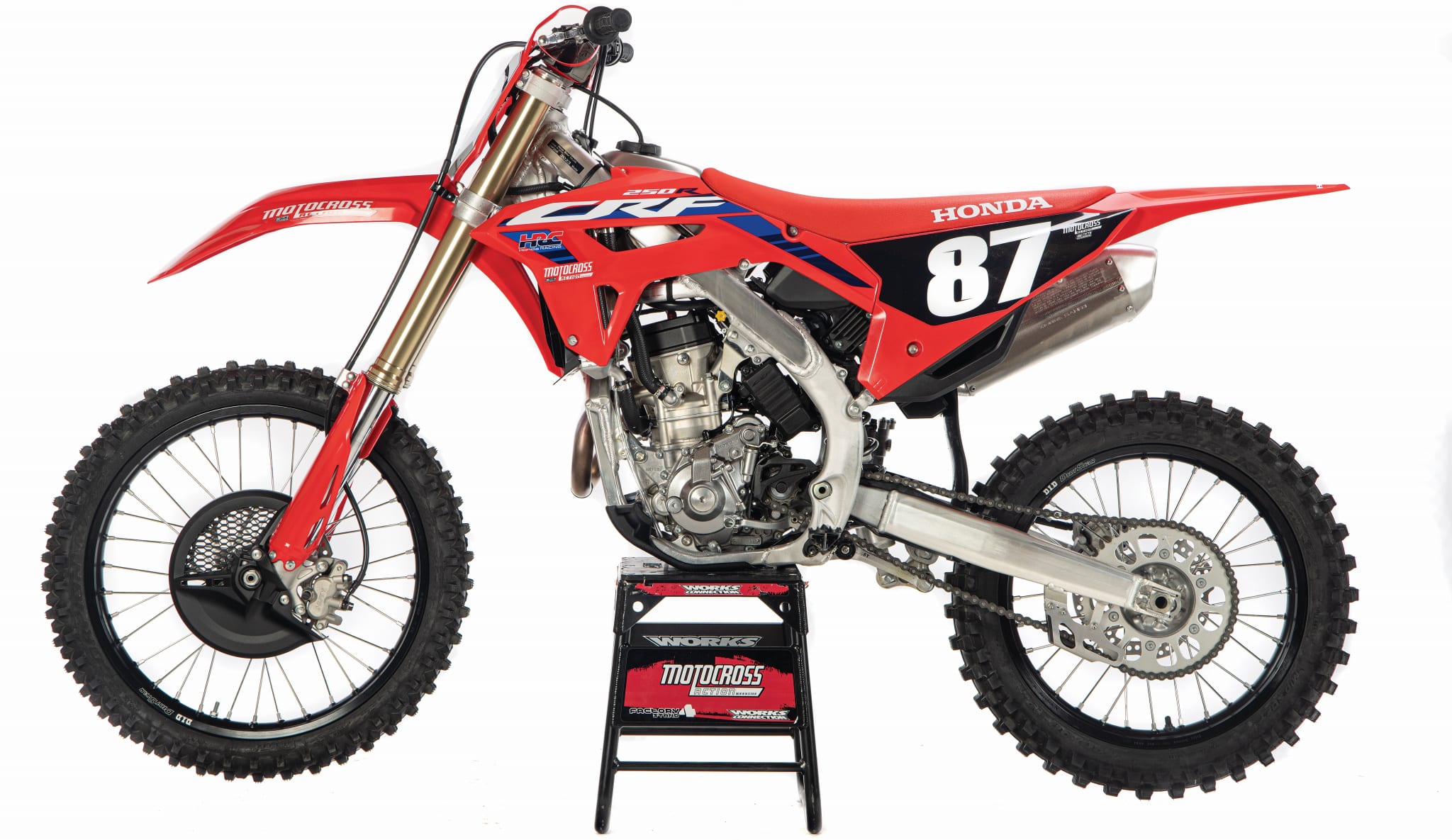 The 2022-’23 CRF250 is 8 pounds lighter than the 2021 and earlier models—and you can feel it.
The 2022-’23 CRF250 is 8 pounds lighter than the 2021 and earlier models—and you can feel it.
Q: WHAT DID HONDA UPDATE ON THE CRF250 ENGINE IN 2022?
A: The 2023 CRF250 is exactly the same as the 2022 bike, but if you haven’t ridden the 2022 model or studied our test on it from last year, we’ve included all you need to know about it here. Our test riders felt pity for the 2018–2021 CRF250 engine. It was fine if you never rode another 250 four-stroke and if you only raced against other CRF250s. But, if you had to line up against Yamaha, Kawasaki, KTM, Husky or GasGas 250F models, the fun factor diminished. Here’s a list of the important engine updates that came on the brand-new 2022 CRF250 and crossed over to the 2023 bike.
(1) Intake. To add low-end torque to the new bike, Honda added a new air intake system (as seen on the CRF450), updated the valve timing and straightened the exhaust port. The newly shaped airbox with an upside-down air filter increased capacity by 78 percent. The fuel injector’s tilt was increased to optimize the spray, and the throttle body was bored out to 44mm.
(2) Head. The four-valve cylinder head’s 33mm intake and 26mm exhaust valves remained the same size, but the valves now feature dual springs (one inside the other) to ensure precise movement at higher revs. The intake camshaft sprocket was press-fit, and the camshaft holder was made more rigid to improve valve timing accuracy and reduce weight. The rocker arm shaft’s alignment was redesigned to improve valve action at higher revs, and the oil volume in the cylinder and oil flow through the engine were increased through a change to the ratio of the oil pump’s drive gear to help durability.
(3) Bore and stroke. The same 79.0mm bore and 50.9mm stroke, along with a 13.9:1 compression ratio, carried over from 2021, but the shapes of the piston and connecting rod were modified, and the water-pump gear was made thicker.
(4) Exhaust. Switching from the dual exhaust to a single exhaust pipe, the CRF250 also added a straighter exhaust port and a muffler that was focused on offering more torque and less weight. The single exhaust header was also bent 74mm closer to the engine on the right side when compared to 2021.
(5) Electronics. The updated ECU gained new mapping in 2022 with three maps: standard (one flashing light), mellow (two flashing lights) and aggressive (three flashing lights).
(6) Clutch. The clutch pack jumped up from an eight-plate to a nine-plate system. The basket was also made more rigid for added durability. The primary gear ratio was also changed to 3.047 from 3.473.
(7) Transmission. The CRF250 transmission went from two shift forks to one, and the gear ratios were adjusted to create more rider-friendly power.
And all those facts remain unchanged on the 2023 Honda CRF250.
Q: HOW DOES THE 2023 HONDA CRF250 RUN ON THE DYNO?
A: The 2023 CRF250’s dyno numbers are sad. It offers less peak horsepower and torque than its predecessor. This sounds worse than it is. Peak power is important, but it isn’t the end all, be all of stats. Horsepower numbers help MXA dissect an engine’s powerband and visually explain how the bike ranks next to its competition, but horsepower positioned in the right areas determines how easy or how difficult a bike is to ride. It’s not about the horse in the fight, it’s about the fight in the horse.
The 2023 Honda CRF250 comes in at 41.32 peak horsepower at 11,830 rpm and 20.07 peak torque, whereas the 2021 CRF250 had 42.06 peak horsepower at 13,000 rpm with 20.15 pound-feet of torque.
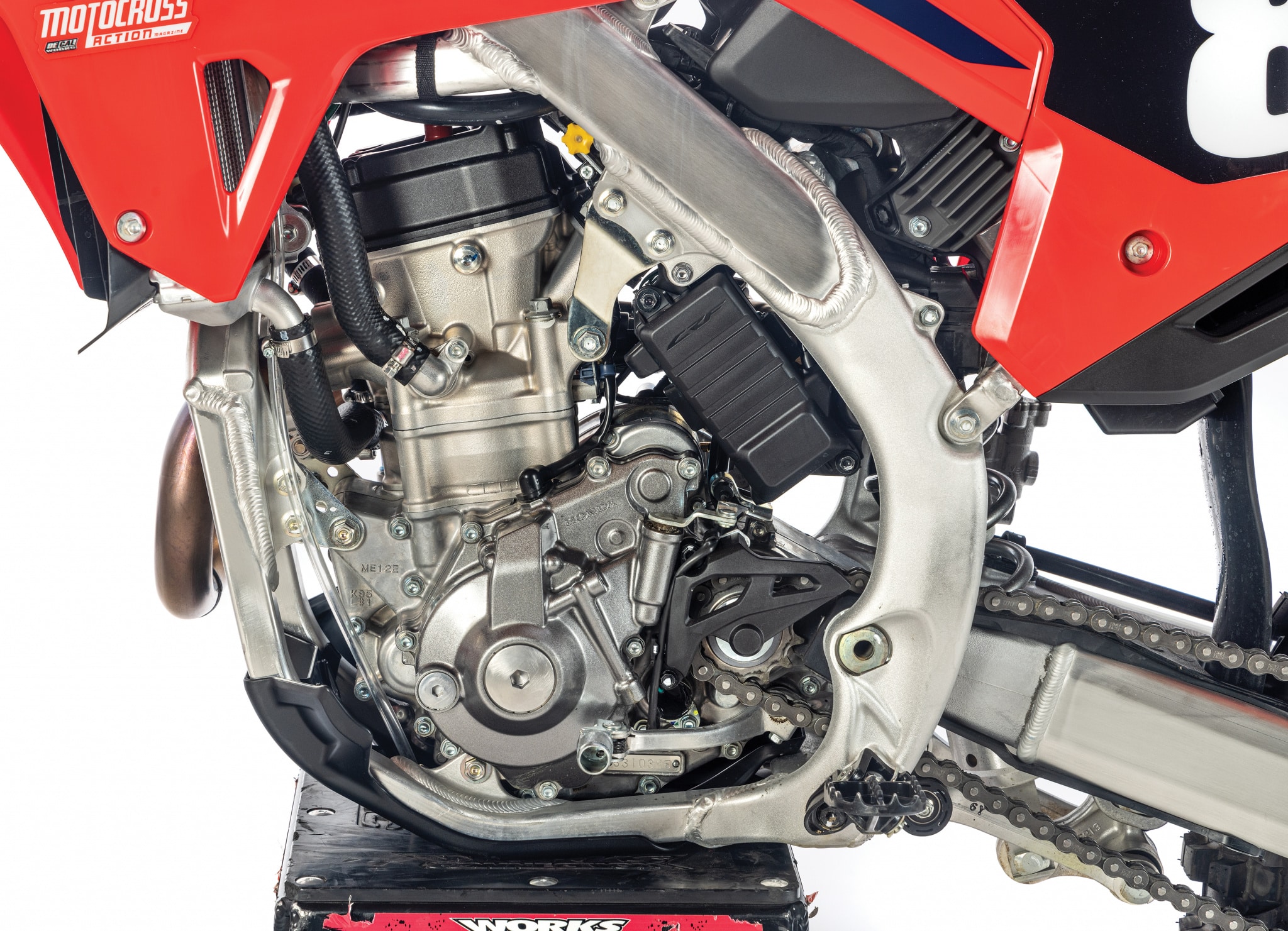 The ’22 and ’23 CRF250 engine is a breath of fresh air. It gets up and goes with authority.
The ’22 and ’23 CRF250 engine is a breath of fresh air. It gets up and goes with authority.
Q: HOW DOES THE 2023 HONDA CRF250 RUN ON THE TRACK?
A: The CRF250 launches off the line like a YZ250F; the stock muffler even makes sounds like a stock YZ250F. It is quick to the punch and charges hard through the gears. This is completely opposite from the 2021 and prior CRF250s. At the crack of the throttle, the 2023 CRF250 is the most exciting and responsive bike on the track. It’s in complete contrast to the 2018–2021 engines, which needed excessive amounts of clutch slipping to get going.
Although the dyno numbers don’t show it, this is a much-improved CRF250 engine over 2021. Honda beefed up the low-end throttle response and low-to-mid power output, which makes the bike much easier to ride. With the previous engine, the clutch was constantly being abused to light up the rear tire to get going on corner exit.
The MXA test riders were prone to making more mistakes on the 2018–2021 CRF250 because it didn’t have the grunt needed to propel the bike forward on corner exit. With a weak bottom end, it’s harder to be smooth in corners, and you’re more likely to put your leg down in the turn. Because the new engine gets up and goes, you can put your feet back on the pegs and charge out of the rut or berm much easier.
Long story short, the 2022–2023 Honda CRF250 engine is much more user-friendly. It’s better for everyone from Beginner to Pro, and it’s a much better starting point for engine tuners to make modifications. Yes, we still have to complain about the fact that the CRF250 lost horsepower with its new engine, but don’t let the dyno numbers scare you. Every MXA test rider prefers the newer engine on the track. This is the best CRF250 engine Honda has ever made, and many of our test riders prefer this engine over the popular YZ250F.
Q: HOW IS THE 2023 HONDA SUSPENSION?
A: The MXA wrecking crew tests motorcycles in their stock form, and we pull no punches when it comes to suspension settings that are too soft; however, from the standpoint of a manufacturer and a motorcycle dealer, soft suspension is better than stiff suspension. The vast majority of dirt bike riders aren’t high-level Pros or Intermediates; they’re Novices. Novice riders need their suspension to be soft to soak up the bumps and provide a smooth and pleasant ride. Most faster riders, who prefer stiffer suspension, already plan to send their stock suspension components off to a tuner anyway. It is a mystery as to why Honda, Kawasaki or Suzuki set up their 250F fork settings for Pros who are going to re-valve the forks immediately. The MXA wrecking crew has a wide range of test riders, and even our Pro testers understand that if the suspension is good for them, it’s probably too stiff for 80 percent of the population who will pay retail price for the same bike.
Honda flew MXA’s Josh Mosiman to Oregon to ride the then all-new 2022 Honda CRF250 at a Pacific Northwest track called Mountain View. It was a beautiful facility that was tailor-made for the new CRF250. The track was privately rented, meaning it wouldn’t get rough like on a normal public practice or race day. The corners were tight, and hills were steep, which highlighted the CRF250’s newfound bottom-end torque. It also had lots of traction, tacky ruts and almost no braking bumps, which benefited the stiff forks. No self-respecting public relations man would fly the press to a new-model intro at a rough and rugged track. Even the 2023 Yamaha YZ450F intro was held on a silky-smooth track at Star Yamaha’s Georgia facility.
Nobody is fooled by this smooth-track ploy. We’ve seen it before, which is why we wait to get the bike back home to SoCal before the real testing starts. On tracks with less traction and real-life bumps, the CRF250 forks were far too stiff. When ridden back to back with other 250Fs, the forks were harsh. For this reason, MXA takes our time testing each motorcycle before writing our final consensus and printing our opinions in the magazine. When developing these suspension settings, Honda must’ve been using Pro-level test riders on tight, tacky tracks in Japan. In these circumstances, they’re good.
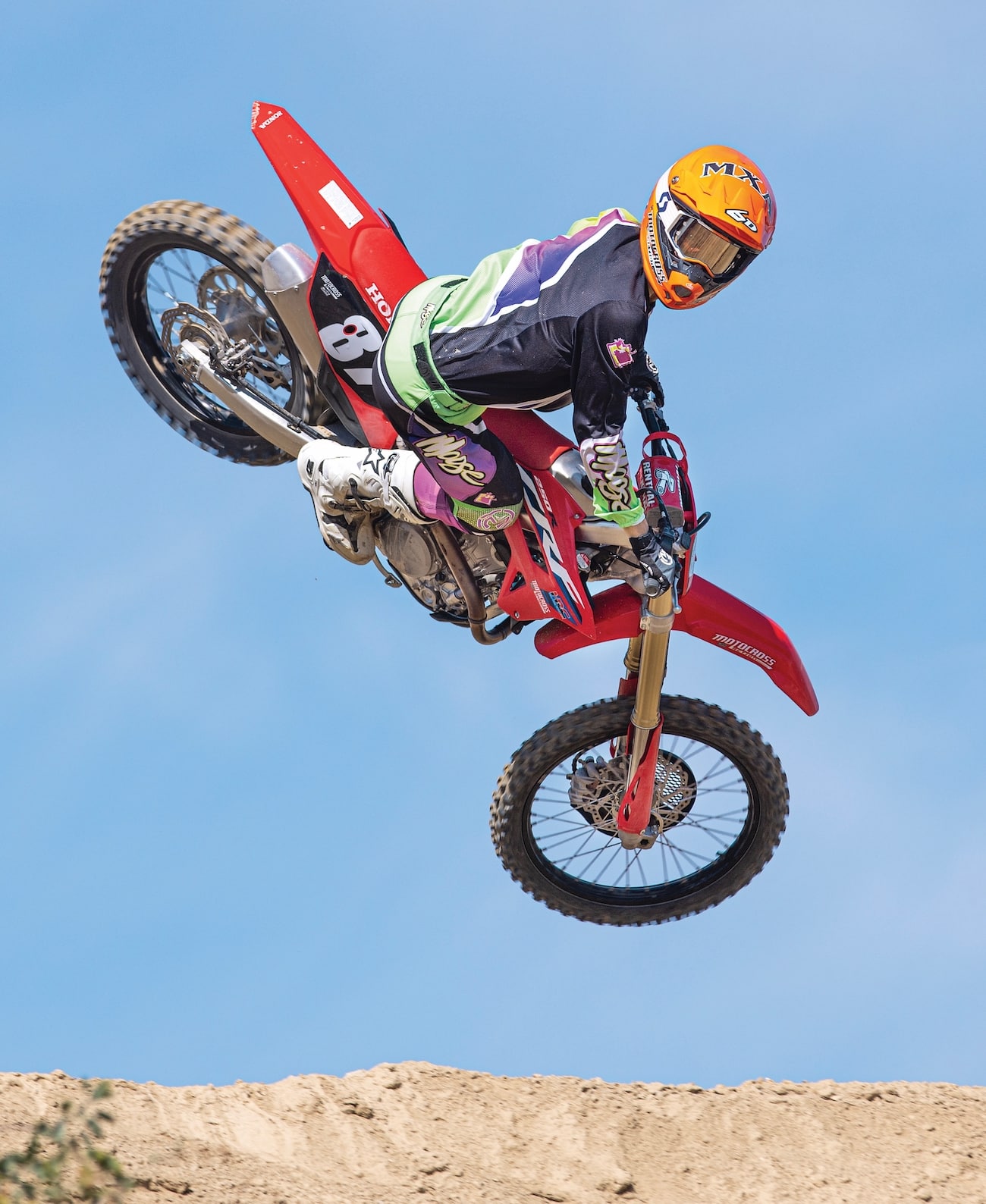 We hated the Pirelli MX32 rear tire. Not so much because of its rubber but because of its width. Honda spec’d a 100/90-19 rear tire to save weight. It is too skinny for a 250F.
We hated the Pirelli MX32 rear tire. Not so much because of its rubber but because of its width. Honda spec’d a 100/90-19 rear tire to save weight. It is too skinny for a 250F.
Q: HOW DOES THE 2023 HONDA CRF250 HANDLE ON THE TRACK?
A: Not so well. As mentioned above, the Showa spring forks are far too stiff, and the CRF250 handling issues start there. We appreciate that the new-generation Honda was made lighter, which helps with hopping over bumps and clearing jumps, but the rigid suspension and frame don’t complement the weight loss; it actually makes our test riders miss the 2018–2021 chassis. That bike was so user-friendly. It had plush suspension, and the chassis felt planted and balanced. We had no worries when putting Beginners and Novices on that bike. Now, we say a prayer whenever a newbie tries out the new CRF250. It’s not an easy bike to hold on to.
The Pirelli MX32 100/90-19 rear tire is also too skinny for a 250F, especially one with great bottom-end torque like the CRF250. The tire choice hurts the handling of this bike in stock form.
As for the rigid frame, it breaks in over time. We recommend using the Ride Engineering 23.5 offset triple clamps to help lengthen the wheelbase and improve stability. The Ride clamps fit on both the CRF450 and CRF250. Obviously, the 450 four-stroke is faster and therefore more difficult to hold onto, making the offset clamps even more beneficial. But, the clamps also help the CRF250. Plus, if you’re a light rider, you can buy the Honda HPSD steering damper and mount from Ride Engineering to help with head-shake.
Q: HOW HEAVY IS THE CRF250?
A: The 2023 Honda CRF250 weighs 219 pounds, making it the second lightest 2023 250 four-stroke in the class behind the 2023 GasGas MC250F. Last year it was tied for the third lightest bike, but since the 2023 KTM 250SXF and Husqvarna FC250 are 5 pounds heavier in 2023, the CRF250 is now the second lightest 250. Oddly enough, the CRF250 didn’t get a single structural change for the 2023 season and actually passed two bikes in the weight category!
The Honda’s big weight loss over the 2021 model can be attributed to Honda dropping its dual-exhaust system for a single exhaust pipe and the Pirelli 100/90-19 rear tire that is too skinny to be taken seriously on a 41-horsepower, 250cc four-stroke. Honda spec’ed it because it saved 2 pounds.
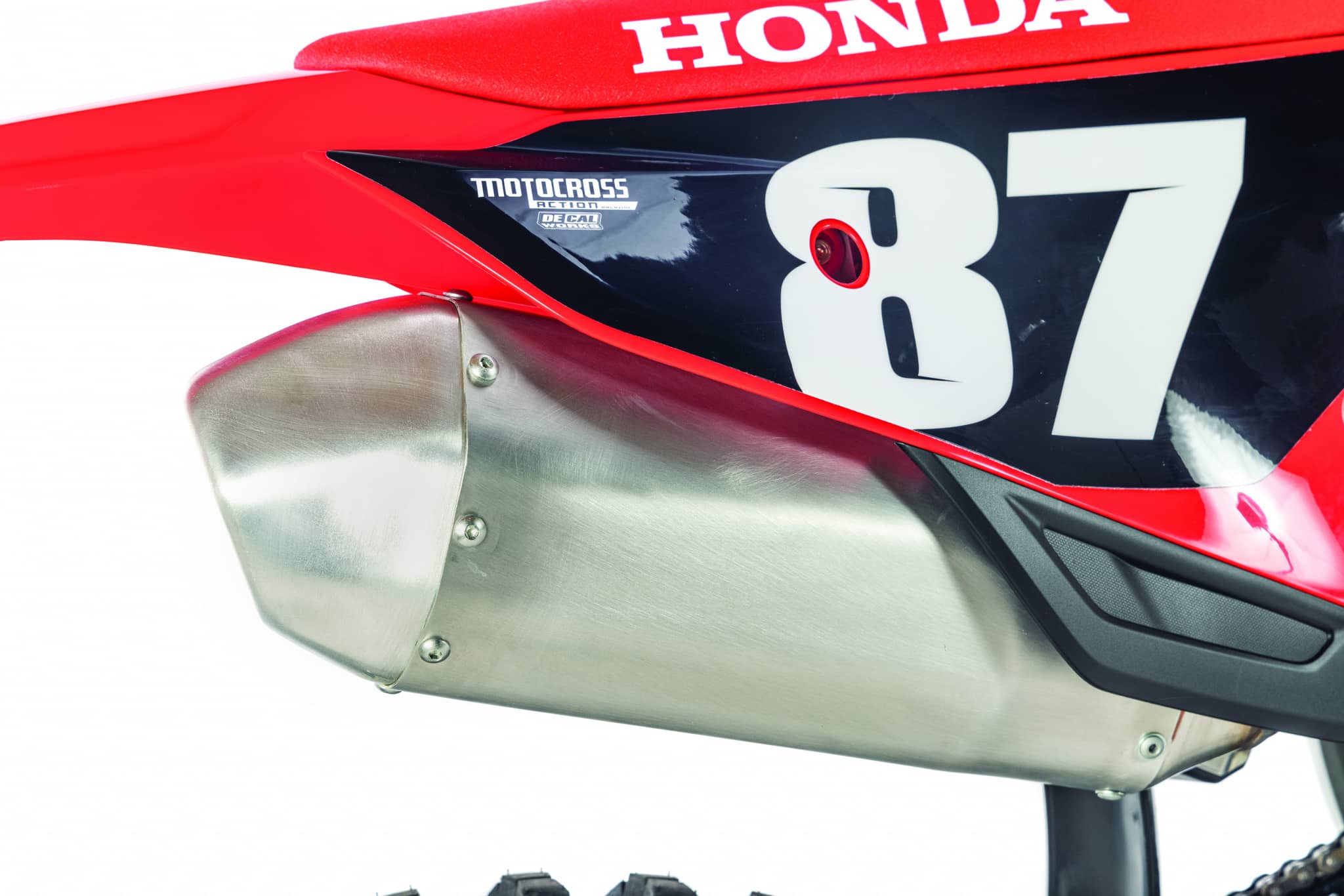 The stock Honda muffler gives off Yamaha YZ250F vibes, literally.
The stock Honda muffler gives off Yamaha YZ250F vibes, literally.
Q: WHAT DID WE HATE?
A: The hate list.
(1) Suspension. The Showa forks are way too stiff. Please, Honda, go back to the 2021 settings.
(2) Tires. The Pirelli MX32 is not the hot rubber on this bike.
(3) Sound. The CRF250 sounds like a YZ250F, and that’s not a good thing.
(4) Radiator cap. The 1.1 kg/mm2 radiator cap should be swapped out for a 1.8 kg/mm2.
(5) Grips. The stock Honda grips are durable but too bulky and rough on your hands.
(6) Airbox. The big vent is good for power, but the upside-down air filter gets dirty quicker than most.
(7) Balance. As with the CRF450, it’s hard to find a happy medium on the fore and aft balance of the CRF250.
Q: WHAT DID WE LIKE?
A: The like list.
(1) Engine. The peak horsepower isn’t there, but it’s impressive how much easier the CRF250 is to ride now. It gets up and goes and allows for smooth corner exit.
(2) Weight. Honda dropped weight in 2022 and kept it off for 2023. KTM and Husky gained weight in ’23, bumping the CRF250 from the fourth to the second lightest bike in the class.
(3) Maps. We like that you can change the maps easily on the handlebars and that they make a noticeable difference on the track.
(4) Clutch. It’s a more durable nine-plate system, and even though it’s not hydraulic like the CRF450, it held up well.
(5) Skid plate. We like that it comes with a lightweight and flexible plastic skid plate right off the showroom floor.
(6) Bodywork. We like the style of the cherry red plastic and the fact that it requires fewer bolts to install plastics nowadays.
(7) Airbox. The CRF250/450 airbox cover isn’t as easy to remove as KTM’s, but it is one-bolt easy.
(8) Ergos. It’s easy to feel comfortable in the CRF250 rider triangle. The Honda footpeg-to-seat-to-handlebar relationship is ergonomically perfect for motocross.
Q: WHAT DID WE REALLY THINK?
A: The 2021-and-earlier-model CRF250s had a workman-like chassis that was easy to set up, but it had a weak-sister engine that stumbled over itself on corner exit. We had to change gearing, make all kinds of mods and use abusive amounts of clutch on corner exit to have any kind of fun on it. Now, the CRF250 has a user-friendly engine that’s easier for Novice riders to maneuver and better for Intermediates and Pros to rip on.
However, the chassis is no longer user-friendly, and you won’t find comfort on it unless you’re a Pro who likes Supercross forks. With the 2022–’23 CRF250, you can save money on power upgrades, but you’ll need to spend money on suspension upgrades.
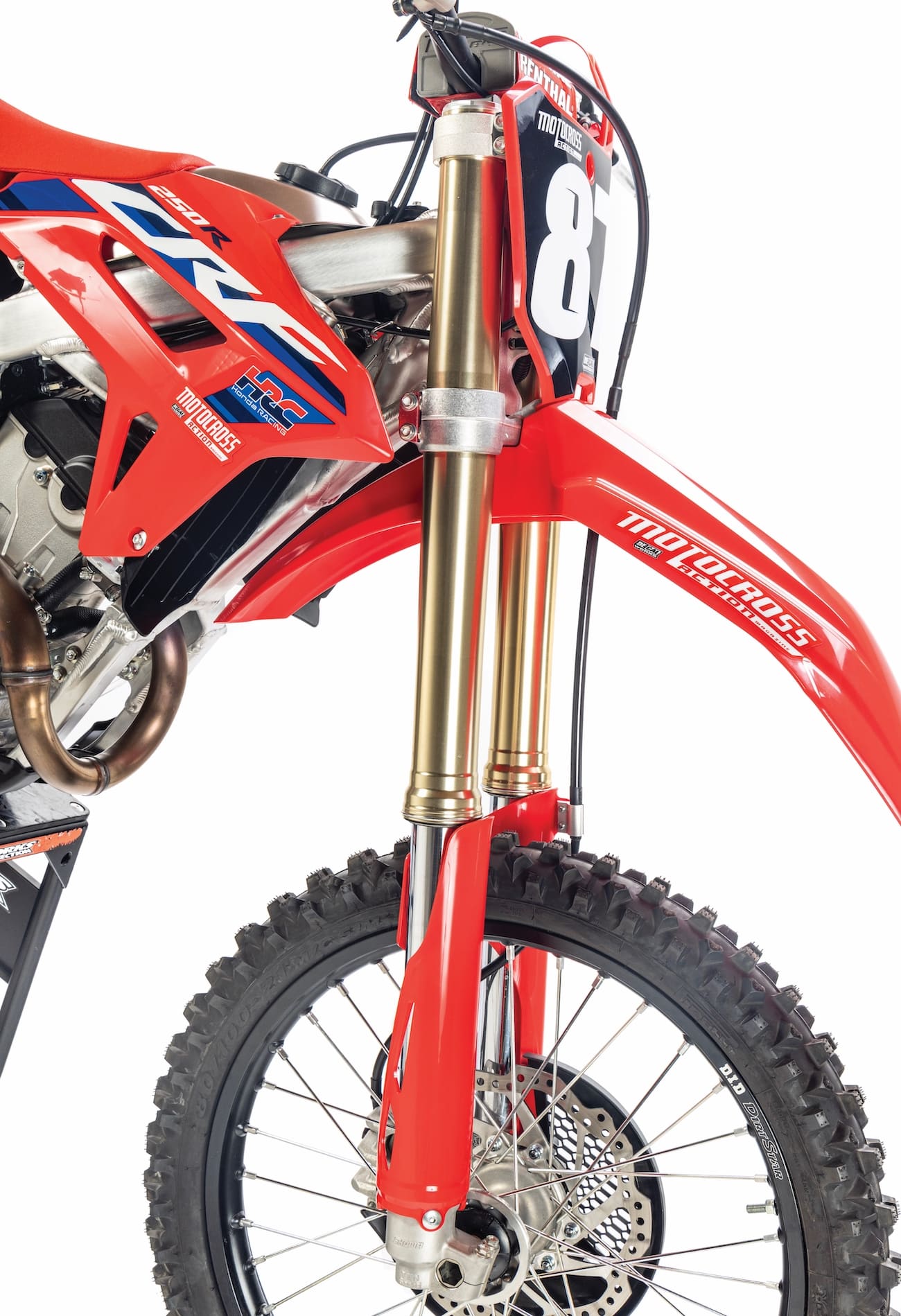 This bike is great once you fix the harshness in the stiff Showa forks.
This bike is great once you fix the harshness in the stiff Showa forks.
MXA’S 2023 HONDA CRF250 SETUP SPECS:
This is how we set up our 2023 Honda CRF250 for racing. We offer it as a guide to help you find your own sweet spot.
SHOWA SPRING FORK SETTINGS
The Showa forks start out good because they ride higher in their stroke than before, but soon after they start compressing, they hit a harsh spot that you just can’t get around. Even our Pro test riders couldn’t bottom them. We lowered the fork oil height, which helped the bike turn better and softened up the initial part of the stroke, but nothing we did could solve the harshness at the end of the stroke. We recommend setting aside money for your favorite suspension tuner to solve this Showa CRF250 fork puzzle. For hardcore racing, these are MXA’s recommended 2023 CRF250 fork settings (stock settings are in parentheses):
Spring rate: 4.8 N/mm
Compression: 7 clicks out (12 clicks out)
Rebound: 11 clicks out (13 clicks out)
Fork-leg height: 5mm
Notes: The Showa forks are sensitive to just one click. When you make adjustments, keep in mind that changes to the front affect the rear and vice
SHOWA SHOCK SETTINGS
The rear suspension system received a revised
rising-rate ratio in 2022 to work with a Showa shock absorber whose shape was changed to fit the new CRF250 frame (with the adjusters moved from the left side to the right side of the bike). The ultra-light steel shock spring for 2022–2023 is a quarter pound lighter than in 2021. The shock was good for most of our test riders with the stock settings. Depending on the weight of the rider, we lowered or raised the in-motion ride height by adjusting the high-speed compression. For hardcore racing, these are MXA’s recommended 2023 CRF250 shock settings (stock settings are in parentheses):
Spring rate: 50 N/mm
Race sag: 105mm
Hi-compression: 2-1/4 turns out (2-1/6 turns out)
Lo-compression: 6 clicks out
Rebound: 9 clicks out (11 clicks out)
Notes: The spring rate is softer than in 2021. If you are on the heavy side, a 52 N/mm spring might be the answer; however, you should probably give your shock to the same tuner who fixes your forks.


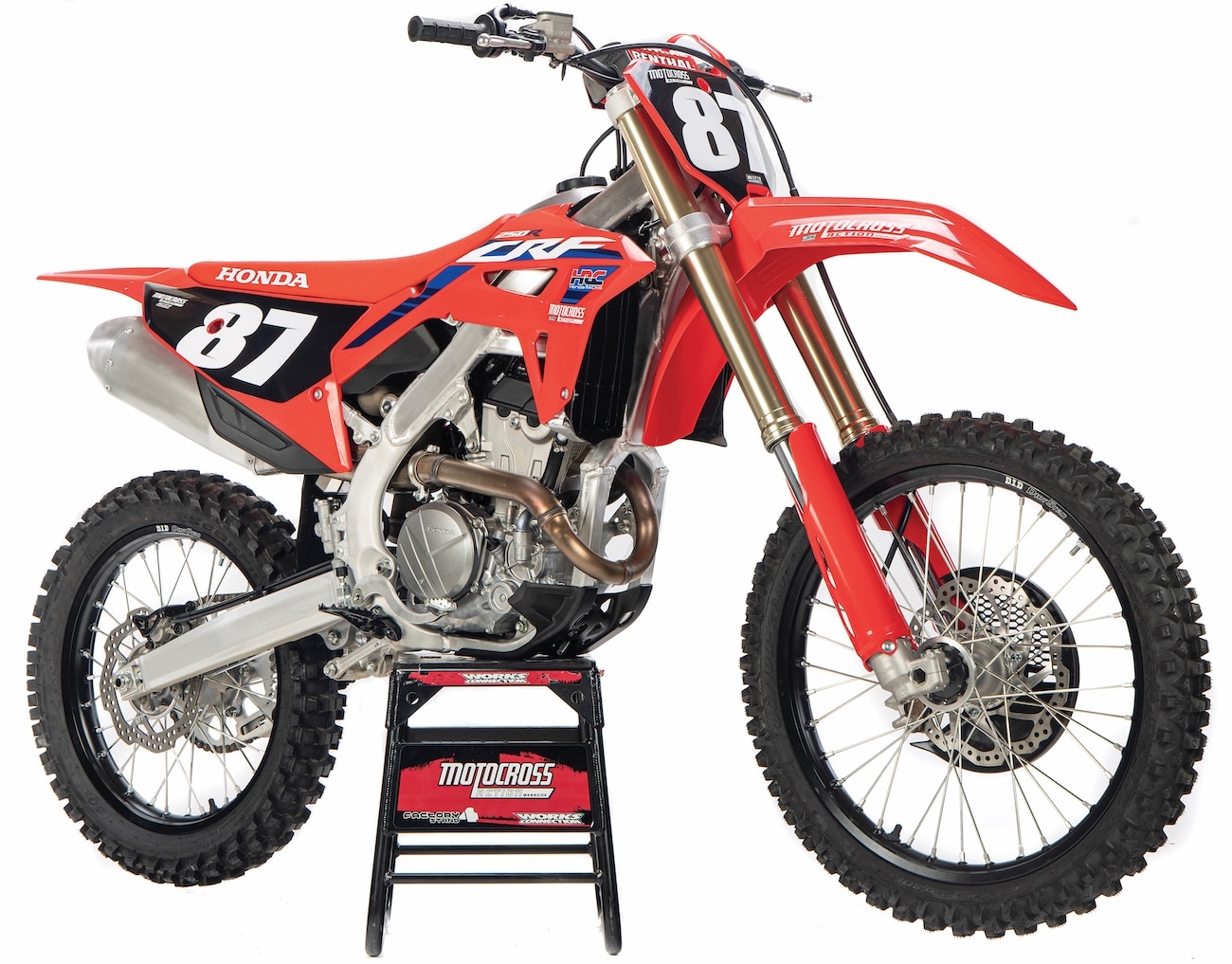
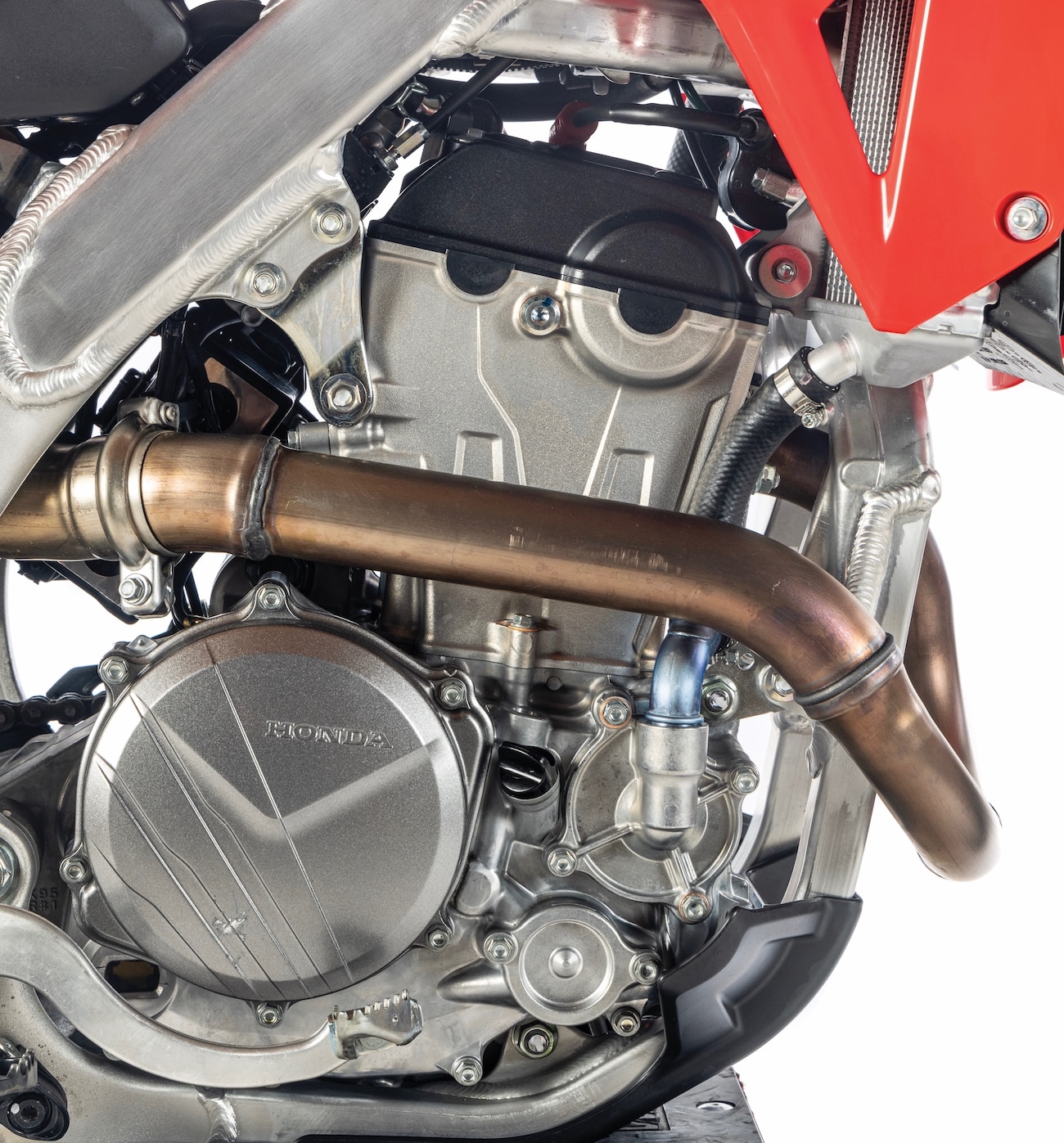
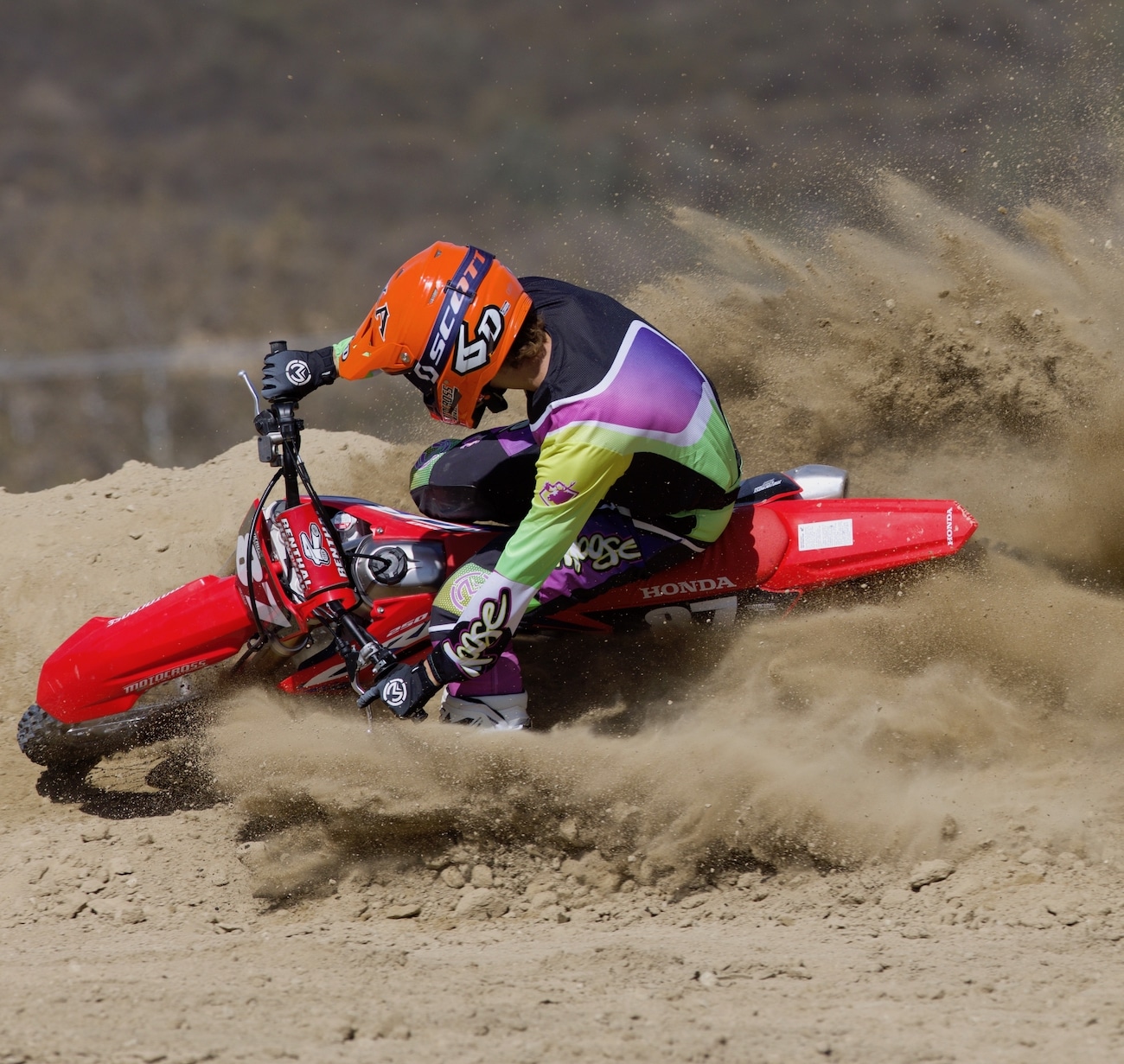

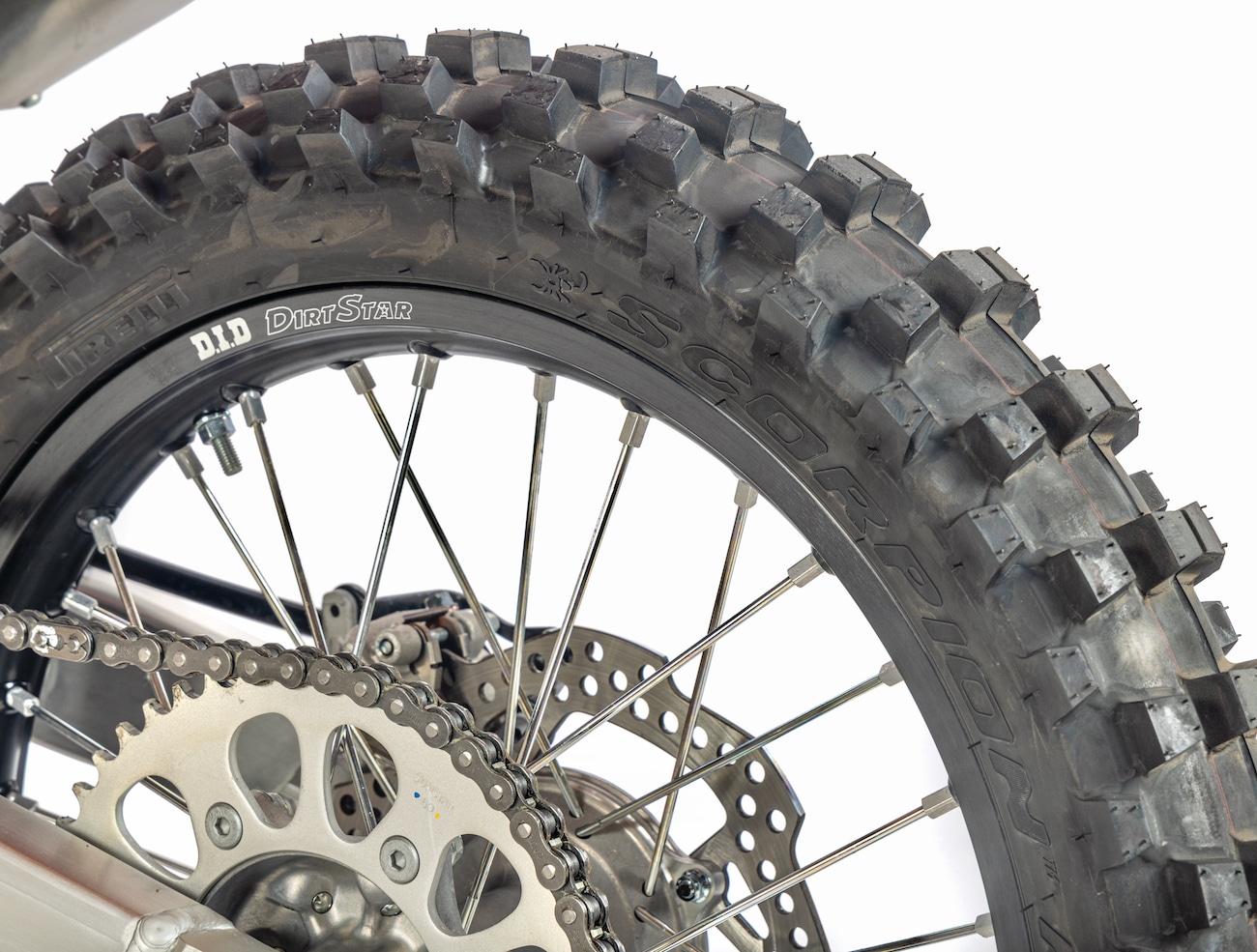



Comments are closed.